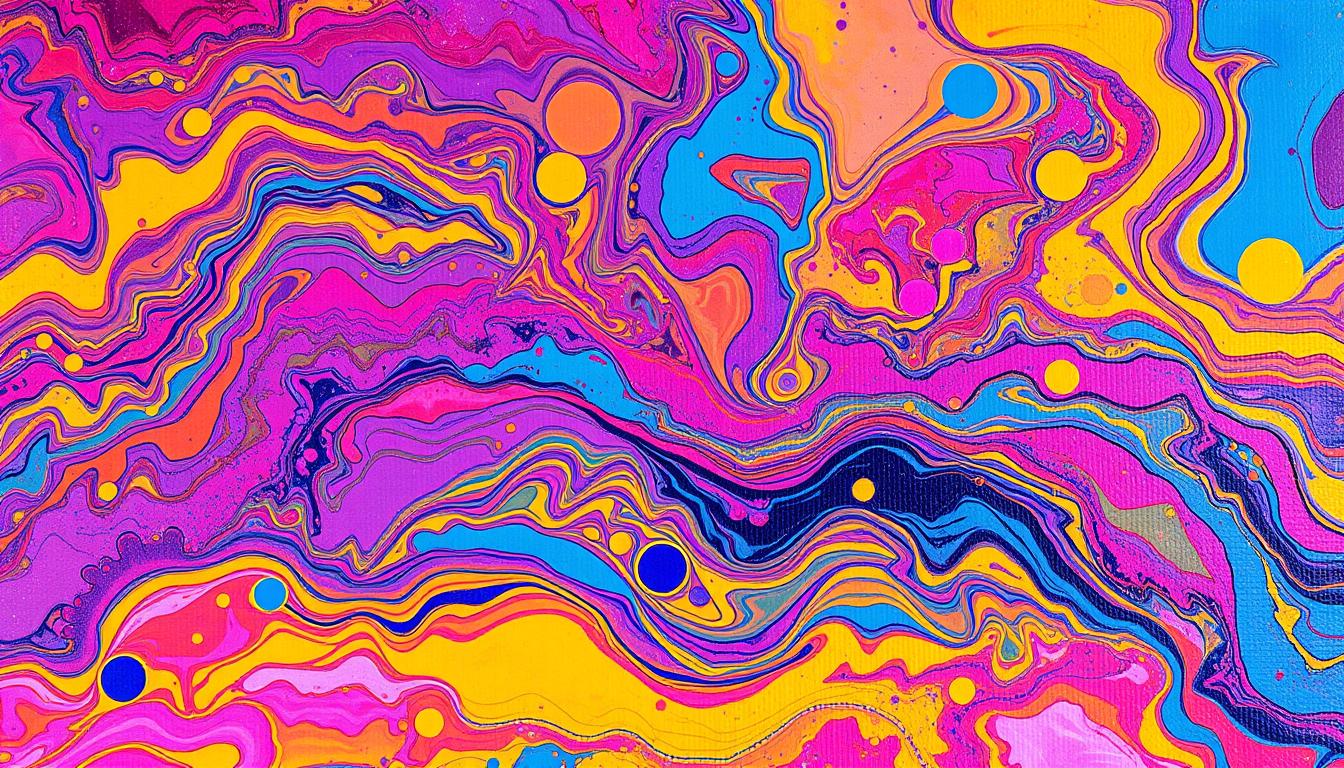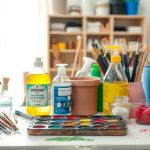Paint effects can transform any room, making it look professional with the right techniques. Creative painting is more than just a hobby; it’s an art form that lets people express their unique style. By using paint effects, homeowners can infuse their personal touch into their space, making it stand out.
With a wide range of techniques and materials, achieving your desired look is simpler than ever. From delicate, nuanced finishes to striking, bold textures, paint effects can dramatically change a room’s atmosphere. Whether you aim to refresh a single wall or an entire home, creative painting is an excellent method to introduce visual interest and depth.
Incorporating paint effects into your decorating plan allows you to showcase your individuality. With some practice and patience, anyone can master the art of creative painting, achieving professional results. Paint effects are an excellent way to personalize your home, reflecting your personality and style.
Key Takeaways
- Paint effects can add a personal touch to any room
- Creative painting is an art form that allows individuals to express their personality and style
- Paint effects can completely transform a room
- There are numerous techniques and materials available to achieve the desired look
- Paint effects can add visual interest and depth to a room
- Creative painting is a great way to update a single wall or an entire house
Understanding Basic Paint Effects and Their Applications
Exploring the basics of paint effects is crucial for creating unique finishes. Faux finishing and decorative painting are key techniques for stunning results. They use specialized paints and tools to produce various effects, from subtle textures to bold designs.
In home décor, faux finishing and decorative painting are prized for adding depth and character. They can transform a space, whether you aim for a rustic or modern look. These methods allow you to achieve your desired style.
Different Types of Paint Effects
Several paint effects are possible through faux finishing and decorative painting. Some favorites include:
- Color washing: applying translucent paint in layers for a soft effect
- Sponging: using a sponge to apply paint for a textured finish
- Rag rolling: applying paint with a rag for a soft, rolled look
Common Applications in Home Décor
Faux finishing and decorative painting enhance room beauty and function. They’re used in various ways, such as:
| Application | Description |
|---|---|
| Accent walls | Creating bold accent walls with faux finishing or decorative painting |
| Furniture decoration | Applying faux finishing or decorative painting to furniture for a unique look |
| Textured ceilings | Creating textured ceilings with faux finishing or decorative painting |
Understanding paint effects opens up creative possibilities in home décor. Whether you’re experienced or new, faux finishing and decorative painting can elevate your projects. They help achieve professional results and add beauty to your space.
Essential Tools and Materials for Decorative Painting
To achieve professional-looking results in decorative painting, having the right tools and materials is crucial. This includes a variety of brushes, rollers, and paints that can help create unique texture techniques. Natural bristle brushes are ideal for oil-based paints, while synthetic brushes work well with water-based paints.
Creating different texture techniques is a key aspect of decorative painting. Specialized tools, such as stencils and stamps, play a significant role. Stencils allow for precise, intricate designs, while stamps can add a more organic, handmade touch. Tools like putty knives, sponges, and rags are also essential for achieving various texture techniques.
- Putty knives for creating textured, layered effects
- Sponges for adding subtle, mottled patterns
- Rags for creating soft, blended edges
Alongside these tools, the right materials are also essential. This includes a range of paints with different finishes and effects, such as metallic, matte, and glossy. By combining the right tools and materials, artists can create a wide range of unique and eye-catching texture techniques that add depth and visual interest to a piece.
With the right tools and materials, the possibilities for decorative painting are endless. Whether you’re looking to add a touch of elegance to a room or create a bold, statement piece, the key to success lies in the texture techniques you use. By experimenting with different tools and materials, you can unlock a world of creative possibilities and take your decorative painting to the next level.
| Tool | Description | Use |
|---|---|---|
| Brushes | Natural or synthetic bristles | Applying paint, creating smooth finishes |
| Rollers | Various sizes and materials | Applying paint, creating textured effects |
| Stencils | Precise, intricate designs | Adding detailed patterns and designs |
Popular Paint Effects Techniques for Beginners
Beginners can start with simple yet effective paint effects techniques to create unique and beautiful artistic finishes. These techniques range from subtle to dramatic effects, achievable with specialty paints and basic tools.
Color Washing
Color washing involves applying a thin layer of transparent paint to a surface. This creates a soft, muted effect. It’s perfect for a warm and inviting atmosphere, suitable for various specialty paints.
Sponging Techniques
Sponging uses a sponge to apply paint in a random, textured pattern. It’s a fun and easy technique for unique effects. It works well with different specialty paints.
Rag Rolling Basics
Rag rolling applies paint with a rag for a smooth, even pattern. It’s ideal for soft, subtle effects. It’s versatile with various specialty paints.
Stippling Methods
Stippling involves applying small dots of paint for detailed patterns. It’s great for unique and interesting effects. It’s adaptable with many specialty paints.
| Technique | Description | Specialty Paints |
|---|---|---|
| Color Washing | Applying a thin layer of transparent paint | Latex, acrylic |
| Sponging | Using a sponge to apply paint in a random pattern | Oil-based, water-based |
| Rag Rolling | Using a rag to apply paint in a smooth pattern | Epoxy, polyurethane |
| Stippling | Applying small dots of paint to create a pattern | Acrylic, enamel |
Advanced Faux Finishing Methods
To achieve high-end, unique finishes, faux finishing techniques are essential in decorative painting. These methods involve layering and glazing to create realistic, beautiful effects. With practice and patience, anyone can master these techniques and transform their space.
Some key faux finishing methods include:
- Layering: applying multiple coats of paint to achieve depth and dimension
- Glazing: using transparent or semi-transparent paints to add color and texture
- Color washing: applying a thin, translucent layer of paint to create a soft, muted effect
When working with decorative painting and faux finishing, it’s essential to remember that practice makes perfect. Don’t be discouraged if your first attempts don’t yield the desired results – keep trying, and you’ll eventually achieve the look you want.
By mastering advanced faux finishing methods, you can create stunning, one-of-a-kind finishes that elevate your space and showcase your personal style.
Whether you’re a seasoned painter or just starting out, decorative painting and faux finishing offer endless possibilities for creative expression and self-expression. With the right techniques and a bit of patience, you can achieve professional-looking results and transform your space into a work of art.
Creating Textured Wall Finishes
Textured wall finishes bring depth and interest to any room, making them a favorite among homeowners and designers. Various texture techniques and paint effects are employed to achieve these unique effects. Sand texturing, for instance, involves mixing paint with sand to create a rough, gritty surface.
Venetian plaster effects require skill and patience, but yield a smooth, high-gloss finish. Dimensional texturing, on the other hand, uses paint and joint compound to create a three-dimensional pattern on the wall.
These paint effects can produce a wide range of looks, from subtle to bold. By experimenting with different texture techniques and materials, one can craft unique and beautiful wall finishes. These finishes add character and personality to any room.
- Sand texturing for a rough, gritty surface
- Venetian plaster effects for a smooth, high-gloss finish
- Dimensional texturing for a raised, three-dimensional pattern
By integrating these texture techniques and paint effects into their designs, homeowners and designers can create stunning wall finishes. These finishes add depth and interest to any room.
| Technique | Description |
|---|---|
| Sand Texturing | A mixture of paint and sand is applied to the wall to create a rough, gritty surface |
| Venetian Plaster Effects | Multiple layers of plaster are applied to the wall to create a smooth, high-gloss finish |
| Dimensional Texturing | A combination of paint and joint compound is used to create a raised, three-dimensional pattern on the wall |
Specialty Paints and Their Unique Properties
Exploring creative painting with specialty paints can elevate any room’s elegance and sophistication. These paints bring unique qualities that enhance a space’s aesthetic, appealing to both homeowners and designers. Options range from metallic finishes to chalk paint and glazing, offering endless possibilities.
Metallic finishes are a standout in specialty paints, adding a sleek, modern vibe to any area. They can range from subtle accents to bold statements. Chalk paint, conversely, is ideal for achieving a vintage or distressed look in your space.
Types of Specialty Paints
- Metallic finishes: available in a range of colors and sheens
- Chalk paint: perfect for creating a vintage or distressed look
- Glazing options: can be used to add depth and dimension to a room
Using specialty paints in your creative painting project can result in a unique, stunning space that mirrors your style. Whether aiming for elegance or a vibrant splash, these paints will undoubtedly make a statement.
| Paint Type | Description | Uses |
|---|---|---|
| Metallic Finishes | Available in a range of colors and sheens | Accent walls, furniture, and accessories |
| Chalk Paint | Perfect for creating a vintage or distressed look | Furniture, walls, and decorative items |
| Glazing Options | Can be used to add depth and dimension to a room | Walls, ceilings, and furniture |
Professional Tips for Achieving Perfect Paint Effects
To master perfect paint effects, understanding artistic finishes and faux finishing is crucial. With the right tools and materials, anyone can craft stunning, unique paint effects. Here are some expert tips to kickstart your journey:
Preparation is paramount for achieving flawless paint effects. This involves thoroughly cleaning the surface, addressing any holes or cracks, and applying a primer if needed. Selecting the appropriate paint and tools, such as premium brushes or rollers, is also vital.
Techniques like color washing, sponging, and rag rolling are popular for artistic finishes. Faux finishing methods, such as marble or wood grain, can elevate any room’s elegance. By adhering to these guidelines and honing your skills, you can produce professional-grade paint effects that elevate your home’s aesthetic.
- Always read the instructions on the paint can and follow the recommended application process.
- Use a test patch to ensure the paint color and finish are what you want.
- Work in a well-ventilated area and use a mask if necessary.
By embracing these tips and unleashing your creativity, you can achieve perfect paint effects. These effects will transform your space, imbuing it with personality and enhancing its beauty.
| Technique | Description |
|---|---|
| Color Washing | A technique that involves applying a glaze over a base coat to create a unique, multi-dimensional finish. |
| Sponging | A technique that involves using a sponge to apply paint and create a textured, irregular finish. |
| Rag Rolling | A technique that involves using a rag to apply paint and create a soft, mottled finish. |
Troubleshooting Common Paint Effect Issues
Decorative painting and texture techniques often come with their own set of challenges. To achieve professional results, it’s crucial to know how to tackle common issues. These include uneven applications, texture problems, and color mismatches.
Common decorative painting issues include uneven color, texture inconsistencies, and poor surface preparation. Understanding the causes and taking corrective action is key. For instance, uneven color can stem from poor mixing or application. Texture issues might arise from incorrect tool use or lack of practice.
Fixing Uneven Applications
To address uneven applications, first identify the cause. If mixing is the issue, remix the paint and reapply. For uneven application, use a level to ensure evenness and apply paint steadily.
Dealing with Texture Problems
Texture issues can be tricky to resolve, but several techniques can help. For overly smooth textures, add a texture additive or change tools. For rough textures, sand the surface and repaint.
Color Correction Methods
Color correction involves adjusting paint hues. This can be done by adding tint or tone and reapplying. Always test on a small area first to avoid mistakes.
By following these tips and practicing, you can master decorative painting and texture techniques. Always adhere to manufacturer guidelines and safety precautions when working with paint.
| Issue | Cause | Solution |
|---|---|---|
| Uneven color distribution | Inadequate mixing or uneven application | Remix paint and reapply to affected area |
| Texture inconsistencies | Incorrect tool usage or insufficient practice | Use correct tool and practice technique |
| Color mismatch | Incorrect color selection or inadequate testing | Test color on small area and adjust as needed |
Maintaining and Protecting Special Paint Finishes
To preserve the beauty of your special paint effects, maintaining and protecting them is crucial. It’s important to use the correct cleaning products and techniques to avoid harming the paint. Regular dusting and gentle cleaning with a soft cloth can prevent dirt and grime from damaging the finish.
For deeper cleaning, a mild soap solution is recommended. Avoid harsh chemicals or abrasive materials that can damage the paint effects. Specialty paints are often more sensitive, so always follow the manufacturer’s cleaning and maintenance guidelines. Proper care ensures your special paint finishes last for years, maintaining their appearance.
Additional tips for maintaining and protecting special paint finishes include:
- Using a clear coat or sealant to protect the paint effects from fading or chipping
- Avoiding exposure to direct sunlight or extreme temperatures
- Not using paint effects or specialty paints in areas that are prone to moisture or humidity
By adhering to these tips and dedicating time to proper maintenance, your special paint finishes will remain in pristine condition. Whether you’re working with paint effects or specialty paints, the right maintenance is essential for lasting results.
Design Inspiration and Project Ideas
Exploring special paint effects opens up a world of endless possibilities. With creativity, any room can be transformed into a unique and stunning space. Creative painting brings a personal touch to walls, making homes stand out. Whether updating a room or the whole house, artistic finishes can be seamlessly integrated into your design.
Start by considering your room’s style and theme. Do you prefer a modern, sleek look or a traditional, elegant feel? Think about colors and textures that match your furniture and decor. Techniques like color washing or sponging can add a unique, eye-catching effect.
Room-by-Room Applications
- Kitchens: Use a bold, bright color to add energy and excitement to the room.
- Bedrooms: Opt for a softer, more calming color to create a relaxing atmosphere.
- Living rooms: Choose a warm, inviting color to make the space feel cozy and welcoming.
The secret to a beautiful paint effect is to have fun and be creative. Don’t hesitate to experiment and try new things. With practice and patience, you can achieve a stunning, artistic finish that enhances your home’s beauty.
Conclusion: Transforming Spaces with Creative Paint Effects
The realm of faux finishing and decorative painting is vast, offering endless ways to transform any space into a masterpiece. Techniques range from bold color washes to the intricate designs of Venetian plaster. The tools at your disposal are virtually limitless.
Whether aiming to add depth to a simple wall, create the look of aged elegance, or infuse a room with personality, mastering faux finishing and decorative painting is key. With the right techniques and practice, you can enhance your home’s aesthetic. You’ll create a unique look that stands out.
Don’t hesitate to try new things and push beyond your usual boundaries. Harness the power of paint and let your creativity flow. The possibilities are vast, and the outcomes will be nothing short of transformative.


